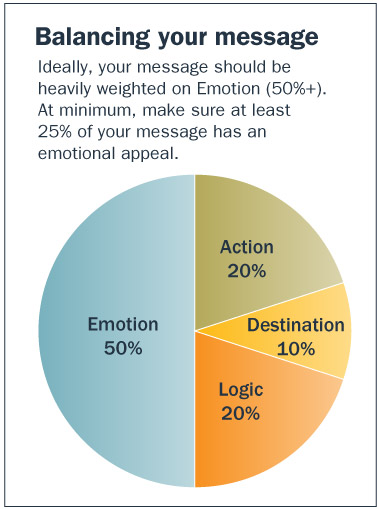
Most change communication messages share the same flaw: They’re 99% fact-driven. Messages typically go like this: “We’re X% behind our competition,” or “We’ll save $X if we change this process.” While employees don’t disagree with data, facts alone are not enough to persuade employees or motivate them to change.
What, then, should you do differently when crafting change messages? Follow a new formula that creates the right balance among four essential elements: logic, emotion, destination and action.
Remember the mnemonic ROY G. BIV (for the colors in the rainbow) and PEMDAS (for the order of operations in math)? Well here’s a new one for you: LEAD (logic, emotion, action and destination). This formula will help you remember four key elements every change message should include—and our visual will help you achieve the perfect balance to make your message meaningful and memorable.
Logic
A good change message should always appeal to employees’ logical side: Here’s the data that proves we need to change. But don’t rely solely on the facts because they can’t create change on their own. If facts could persuade, no one would smoke, eat foods with trans-fat or text while driving.
Emotion
Often overlooked is the premise that a good change message must appeal to employees’ emotions. In fact, studies have proven that an emotional appeal is a more effective way to change behavior than a logical appeal. The best emotional messages take into account your organization’s culture and appeal to employees’ sense of identity. For example, if being the best is part of your DNA, a change message might say, “This change will help you be more innovative so we can succeed.”
Action
The first question employees ask when they hear about change is this: “What do you need me to do?” That’s why the more specific you can be about how an employee can take action, the better.
Destination
We all know change is hard. So it’s important to reinforce an attractive destination that employees can aim for. The best destination is both logical—“This is where we’re headed and why it makes sense”—and emotional: “When we get there, we’ll be stronger and more successful.” Change is hard work, but the destination gives employees hope that the difficult journey will be worthwhile.



